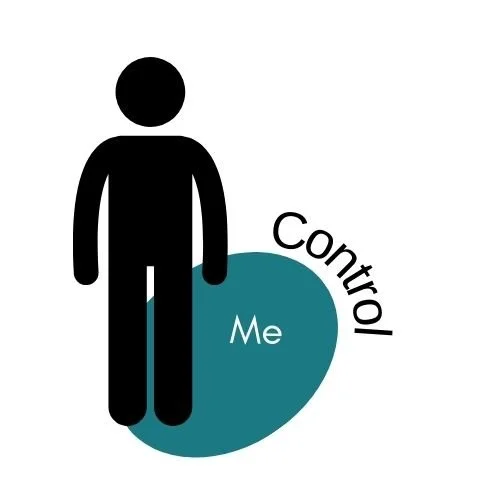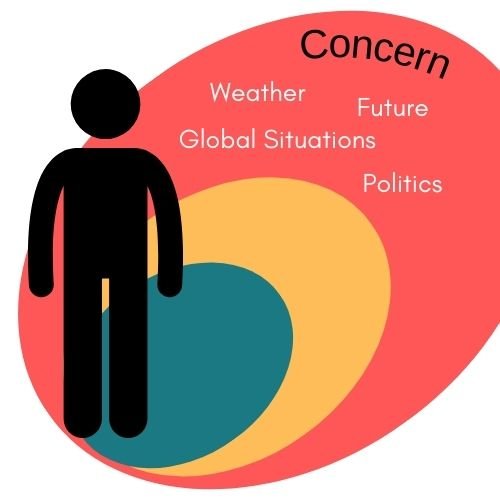The Injustice Crusader:
Turning your Justice Sensitivity into your greatest ADHD superpower
Like so many of the ADHD brain’s unique attributes, ADHD justice sensitivity can feel like just one more component of the ADHD experience that causes extra pain and struggle-- feeling all the pain of the world, stuck on the couch doomscrolling into the wee hours of the morning, suffering because of the suffering of others.
But it can also be yet another superpower- another unique part of your brain’s mode of operating that when fully understood and worked with, can create monumental change in your life and in the world.
How do you do that?
The key is using all that pent-up injustice energy to fuel your drive towards making change where you can. And the cool thing is that the more practice you have at making that kind of change, the more power you have and the more change you can create.
How?
Well, it’s all about understanding your circles of influence, control, and concern.
What’s your Circle of Control?
Imagine you’re standing still and someone drew a small circle on the ground around your feet. This is your circle of control- the things inside this circle- those are the things you have true control over.
Now, remember- I said it was a small circle. So small, in fact, that only one person can fit in it: you. Because ultimately, that’s all we have control over– ourselves.
Now, of course, there are some aspects, even of ourselves that we don’t have complete control over, right? Like our health, the type of brain we were born with, or the color of eyes we have. But most of us have some measure of general control over our actions, choices, and bodies. We chose what clothes we wear if we speed on the expressway, what we have for breakfast, or whether or not we recycle our plastic.
What’s your Circle of Influence?
Now, there are other things that we don’t have control over but we do have some ability to influence. These are the things in our circle of influence.
Your circle of influence is quite a bit larger than your circle of control. And it includes some things about you- like your health or your career and then numerous people, situations, and things outside of you— like the actions of your family, friends, coworkers, and even strangers in your immediate vicinity. Your circle of influence includes all of the people, situations, patterns, and events of your life, as well as anything else that you interact with.
But remember- this is your circle of influence. These are things you can help change or influence- NOT things you can control.
For example, you can influence your 90-year-old mother who insists that she can drive at night by talking to her about it, expressing your concern, and maybe even talking with her doctor (actions inside your circle of control). But you can’t control if she actually picks up those keys after the sun goes down.
Now, one thing about our circle of influence is that the farther something is from you in that circle, the less influence you are likely to have over it. So, yelling at your son to put on his shoes may impact him more strongly than yelling at a stranger on the street. But again- influence is not control, so that impact may not actually make your son put his shoes on.
What’s your Circle of Concern?
But there are things that no matter what we do, we have little to no control or influence over. This is our circle of concern. These are the things that we worry about, that we ruminate over, that we doomscroll through. And these are the things that often keep us stuck.
These are things like the weather, global climate change, national policies, international relations, the course of a project that you aren’t working directly on, the future, etc.
Doomscrolling: The Circle of Concern Quicksand
The draw of the circle of concern is magnetic- particularly for a justice-sensitive, ADHD brain. It keeps it sucked in with its steady, low-level stream of adrenaline, while also allowing your brain to stay in its comfortable default mode network, rather than having to scale a wall of awful to get into action.
And so we obsess- reading news article after news article descending into a downward spiral of despair, getting so stuck in our circle of concern that we feel powerless to make a change and we lose sight of those things we do have influence and control over. And it feels like an endless pit of quicksand- the longer you stay there, the deeper you sink.
Your circles of Influence and Control: Your well-being and world-changing superpower.
Now you may say- Marcy, I have influence over national policies by voting or I can impact climate change by recycling and reducing my carbon emissions. And if that’s where your head went- then- awesome! That’s exactly where you want to be focusing: on your circle of control and the influence you do have on the bigger picture.
Because that’s where you have power- staying in your circles of control and influence- that’s where the good stuff happens. In fact, it has been proven, again and again, that when people focus their efforts and thoughts on the things within their circles of control and influence they are:
Happier
Less Anxious
Have a greater sense of well-being
More successful
When you focus on the things you can control (your own thoughts, behaviors, actions) primarily and the things you have influence over (people, things, situations around you) to a secondary degree, you’re able to change the things you don’t like and/or change the way they impact you.
This not only allows you to maximize your comfort and enjoyment but it does wonders for your sense of power and control in the world. In fact, psychologists have found that the trait that is most likely to result in both depression and anxiety is a tendency to see things as everlasting and unchangeable (ie: the opposite of being capable of being influenced and controlled).
Let's see how this works:
Imagine you are planning a BBQ for a week from Saturday. And you look at the weather forecast and it calls for thunderstorms that day. You have 2 options:
1. You can focus on your circle of concern and worry and stress about if it might rain and how miserable you’ll all be.
2. You can look into your circle of influence and control and take action, like: scheduling a raindate, finding an alternate location, heck- you could even tell everyone to wear their raincoats and Wellys!
Or, let’s try a different one: let’s say you are scrolling on your phone and see the news report after news report about a humanitarian crisis happening halfway across the world. Your heart breaks for the pain and suffering of all the people plagued by the situation. Here you have the options to:
1. Keep doomscrolling until the wee hours of the morning, focused on your area of concern leaving you sad, tired and hopeless.
2. Look to your circle of influence and see how you can help. Can you donate to a clothing or supply drive supporting those affected, can you call your state official and let them know how you would like them to respond, or can you start your own fundraiser for the cause?
When you consciously change your focus from the area of concern to your area of control and influence, you get to shrug off the shackles of hopeless despair and instead don the cape of injustice crusader.
How to Supercharge your Circle of Influence
As if the fact that focusing on your circle of control and influence will make you happier, less anxious, more successful, and can actually change the world wasn’t cool enough- you can supercharge that satisfaction-making machine and make your circle of influence BIGGER!
That means more things, more people, more situations, AND greater influence!
Sound too good to be true? Well, I promise you, it’s not.
Because when we focus our efforts on our circles of control and influence they actually grow- expanding your reach and your power.
For example- let’s say the plight of the homeless is something that sends your justice sensitivity cape flying. If you focus on the giant problem as a whole, you’re likely to feel hopeless and helpless.
But if, instead, you decide to use your justice sensitivity to fuel you inside your circle of influence and you cook a meal for your local homeless shelter. You just influenced the hunger of all of the shelter residents that night. Congrats!
Now, if you keep focusing and acting within that circle of influence- making more and more meals; you’re likely to meet and get to know the people that work and live at the shelter. And really getting to know the people may allow you to understand the issues involved which then gives you a great idea for a program to address some of the underlying issues at play. And because you now know so many of the shelter workers and officials, you’re able to collaborate with them to implement your new program.
When you first started, your circle of influence was simply over the hunger of the few people at that shelter on that day. But the more worked in your circle of control and influence, the more people and situations it included — growing to encompass not just those people that first day, but maybe all the homeless people in your city.
Turning Justice Sensitivity into an Injustice Crusader
So the basic principle is clear- if you focus and act on your circle of control and influence, not only are you happier and more successful— but you can increase your impact over time.
But, how does an ADHD brain, magnetically attracted to the circle of concern, and not always able to direct its attention or force itself into action, stay out of the justice sensitivity fetal position and don its cape as the Injustice Crusader it has the power to be?
Well, you know me- I’ve got a couple of steps for that!
Track your Justice Sensitivity Red flags
Think of a time that your justice sensitivity sent you into the circle of concern quicksand. What did it feel like? What were the signals in your body? Did you start to get a headache? Did your shoulders feel tight? Was your breathing more rapid? These are your justice sensitivity red flags. These are your body’s signals to your brain that it needs to find an area of control and take action.
Chart your circles
Now that you know what your red flags are, the next time you experience them, you can use them as a signal to chart your circles- draw 3 concentric circles and place your worries/ fears/ empathic concerns in their appropriate circles. Next, think about what parts of that overall topic can be placed in your circles of influence and control.
Take one small action
We can only act within our circle of control, and action is what turns despair into superpower. So, the final step is to take one small action within our circle of control. Knowing that the more we focus there, the more time we spend on these small actions, the greater our power becomes.
So, don’t let your justice sensitivity molder into hopelessness and despair, whip out your Injustice Crusader cape, and take action inside your circle of control!
Ready to shift from
meltdown to mastery?
This online course has been designed specifically to help teach the strategies ADHD brains need to help them move from overwhelm and meltdowns to confident emotional mastery.
Want to know more about
thriving with ADHD?
Check out these other articles:












ADHD Packing Tips: Master Stress-Free Travel with these ADHD Hacks